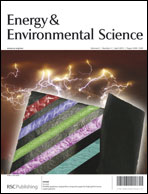Water-soluble K7[CoIIICoII(H2O)W11O39] (1) was tested as the first cobalt-containing Keggin polyoxometalate catalyst for efficient O2 production via both visible-light driven and thermal water oxidation. Under the optimal photocatalytic conditions [photoirradiation at λ ≥ 420 nm, [Ru(bpy)3]Cl2 as the photosensor, Na2S2O8 as the oxidant in borate buffer (pH = 9.0)],the turnover number (TON) can reach as high as 360, the initial quantum yield and the initial turnover frequency (TOF) for the first 60 seconds was 27% and 0.5 s−1, respectively. Variables of the photocatalytic reaction, including catalyst concentrations, buffer types and concentrations, pHs, dye concentrations, oxidant concentrations, etc., were systemically studied. The oxygen atoms of the evolved oxygen came from water, as confirmed by isotope-labeled experiments. In the thermal water oxidation, the TON and oxygen yield were measured to be 15 and 60%, respectively. The stability of 1 was tested and confirmed with multiple experiments (laser flash photolysis, DLS, CV, FT-IR, EDX, and catalyst recycling) within the photocatalytic water oxidation duration, which ruled out the possibility that neither the free Co2+ ions were present in the reaction solution nor were cobalt oxide/hydroxide nanoparticles in situ formed from the assumed decomposition of 1. All the evidence stated here collectively supports that 1 is the true molecular catalyst. In addition, the recycled sample was reused for water oxidation catalysis and showed similar catalytic behaviors (kinetics and activity) to that of the freshly prepared catalyst. No insoluble forms where found when the borate buffer solution of 1 was aged for 2 months, whereas its analogue, K8[CoIICoII(H2O)W11O39] (4), is rapidly decomposed to a blue-purple cobalt oxide precipitate in borate buffer. The stability difference between 1 and 4 indicates that the +3 oxidation state of the central cobalt in 1 plays a vital role in maintaining the structural integrity. A series of other Keggin-type POMs, such as K6[CoIIW12O40] (2), K5[CoIIIW12O40] (3), K6[SiCoII(H2O)W11O39] (5), and K5[PCoII(H2O)W11O39] (6), were also evaluated for their catalytic activity by comparison with 1. Our study demonstrates that the unique structural features of the mixed-valent central and peripheral cobalt atoms are essential for 1 to maintain both catalytic stability and efficiency.
![Graphical abstract: K7[CoIIICoII(H2O)W11O39]: a molecular mixed-valence Keggin polyoxometalate catalyst of high stability and efficiency for visible light-driven water oxidation](/en/Image/Get?imageInfo.ImageType=GA&imageInfo.ImageIdentifier.ManuscriptID=C3EE24433D&imageInfo.ImageIdentifier.Year=2013)

 Please wait while we load your content...
Please wait while we load your content...